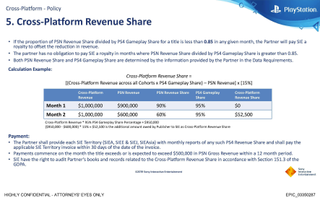Sony charges for crossplay support to protect PSN revenue, documents show
Epic lawsuit shows that Sony gets royalties if too many PlayStation players spend money elsewhere.

In 2018, a public outcry from Fortnite players seemingly pushed Sony to finally support crossplay on the PlayStation 4. Until its big shift with Fortnite, Sony had repeatedly chosen not to support crossplay for other games like Minecraft and Rocket League. Newly-released documents from the Epic Games v Apple lawsuit now show how Epic tried to negotiate with Sony for crossplay, and that once Sony did finally allow cross-platform play, it began charging developers based on how much their game earned on other platforms.
In a 2019 Sony document titled "Cross-platform revenue share," Sony outlined a royalty payment policy for games that earn a significant portion of their money on platforms other than the PS4. "If the proportion of PSN Revenue Share divided by the PS4 Gameplay Share for a title is less than .85 in any given month, the Partner will pay SIE a royalty to offset the reduction in revenue."
That's a bit dense, but the gist is that Sony wants to ensure that PlayStation players aren't running off to spend their money elsewhere while still relying on Sony's servers/infrastructure.
Sony's example chart breaks down how its royalty payments would work. It shows how a game earning $1 million in a month across all platforms would owe Sony no crossplay royalties if $900,000 of that total came from PSN, while 95% of the total playerbase was on Sony's platform. In that scenario, the PSN revenue share works out to 90%—above Sony's 85% threshold, meaning no royalty is owed.

Sony's justification for the royalty payment seems to be its way of ensuring that if a ton of players are on its platform, it's going to see a proportional amount of revenue on PSN too, where it gets a 30% cut of in-game purchases.
If 20% of the total Rocket League playerbase were on the PS4, for example, but PlayStation players accounted for only 10% of the game's revenue (because players buy way more skins on PC, or something), Sony presumably thinks it's paying the PSN infrastructure costs for all those players but not getting the return it should for allowing cross-platform play. To "offset the reduction in revenue," the game publisher would owe Sony a royalty payment based on the gap between the PS4 playerbase and proportional PSN revenue.
To enable crossplay under the agreement, developers are required to share monthly reports with Sony detailing the PS4 revenue share.
PC Gamer Newsletter
Sign up to get the best content of the week, and great gaming deals, as picked by the editors.
Based on this document, Sony isn't outright charging for crossplay on PlayStation, though it is just one page from what seems to be a larger policy packet on crossplay. Only the revenue share page was submitted for the Epic v Apple court case. Since the document was created in 2019, it's possible Sony's approach to crossplay has changed in the last two years, but according to Epic CEO Tim Sweeney, Epic had to agree to the terms for Fortnite crossplay to be allowed on the PS4. "If somebody were primarily playing on PlayStation, but paying on iPhone then this might trigger compensation," he said in court on Monday.
Epic CEO Tim Sweeney just confirmed that Sony is the only platform holder that requires Epic to pay compensation for crossplay. Epic had to agree to pay these additional fees to enable crossplay in Fortnite.May 3, 2021
Sweeney also said that Sony is the only platform that requires compensation for crossplay support. I've reached out to Sony PR for comment on whether its policy has changed since 2019, as well as Microsoft to ask whether it has comparable crossplay policies.
An email exchange between Sony and Epic from early 2018—before the revenue share plan was established—offers an interesting glimpse into the negotiation to get Fortnite crossplay working. Epic's Joe Krenier, who worked on business development for Unreal Engine, wrote that "I can't think of a scenario where Epic doesn't get what we want—that possibility went out the door when Fortnite became the biggest game on PlayStation." Krenier proposed multiple enticements to Sony to support crossplay, including sharing marketing data, branding Fortnite's E3 presence with PlayStation and Epic going "out of its way to make Sony look like heroes" when crossplay support is announced.
Krenier also pitched a potential future PSVR exclusive and even brought up the terms of Sony's companywide Unreal Engine 4 license, which he pointedly mentioned was expiring in May 2019. "That license has some of the best terms we've ever offered for UE4," Krenier wrote. "Let's make this a huge win for us all. Epic's not changing its mind on the issue, so let's just agree on it now."
Sony remained unconvinced at the time. Former senior director Gio Corsi wrote back "There are a lot of great ideas in here for continued partnership however cross-platform play is not a slam dunk no matter the size of the title. As you know, many companies are exploring this idea and not a single one can explain how cross-console play improves the PlayStation business." It wasn't until months later, in September 2018, that Sony acquiesced and began supporting crossplay.

Wes has been covering games and hardware for more than 10 years, first at tech sites like The Wirecutter and Tested before joining the PC Gamer team in 2014. Wes plays a little bit of everything, but he'll always jump at the chance to cover emulation and Japanese games.
When he's not obsessively optimizing and re-optimizing a tangle of conveyor belts in Satisfactory (it's really becoming a problem), he's probably playing a 20-year-old Final Fantasy or some opaque ASCII roguelike. With a focus on writing and editing features, he seeks out personal stories and in-depth histories from the corners of PC gaming and its niche communities. 50% pizza by volume (deep dish, to be specific).
Most Popular





